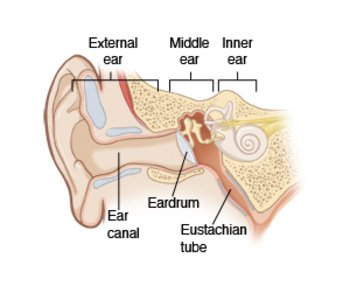

Get the best Chronic Otitis Media Treatment in Noida, Uttar Pradesh, India by best ENT surgeon
Chronic otitis media is a long standing inflammation of the middle ear cleft that affects thousands of people in our country. It is one of the most common reversible causes of hearing loss an ENT surgeon comes across in clinical practice. Based on pathophysiology, it can mainly be divided into two types: Mucosal and Squamosal
1. Mucosal: This type is characterised by inflammation of the middle ear mucosa because of a perforation in the tympanic membrane ( ear drum).
2. Squamosal: The hallmark of this type is bony erosion caused by an entity called cholesteatoma in the middle ear cleft. Retraction pockets, granulations and attic erosions are other features of the squamosal type.

The two most common symptoms of chronic otitis media are ear discharge and hearing loss. The mucosal variety is usually characterised by profuse mucoid ear discharge which is mostly non foul smelling and non blood stained. It may increase in amount with the advent of a common cold. The squamosal type is characterised by scanty and purulent ( pus like) ear discharge which is foul smelling and on occasions may even be blood stained. The next most common symptom is hearing loss. The hearing loss is usually conductive and may vary in severity. Sometimes, it may be severe enough to affect the daily activities of a patient. A few patients of long standing untreated chronic otitis media may end up with sensorineural type of hearing loss which is usually irreversible. The other symptoms could be ear heaviness, discomfort and pain. Severe ear pain, ear swelling, headache, fever, neck swelling, seizures, vertigo are cardinal symptoms that could point towards a complicated chronic otitis media
The mucosal variety of chronic otitis media is usually secondary to a perforation in the tympanic membrane (ear drum). The perforation may be caused due to an infection or trauma to the eardrum. The perforation, this caused, does not heal and becomes permanent after it’s margins are epithelized. The mucosa of the middle ear ( the area behind the eardrum) becomes chronically exposed to the external environment because of the perforation, which leads to repeated infections of the middle ear and ear discharge. The pathophysiology behind the squamosal variety is slightly more complicated. Eustachian tube dysfunction is the most accepted hypothesis to explain this variety. Any cause leading to improper functioning of the eustachian tube leads to negative pressure in the middle ear which leads to retraction pockets in the ear drum. These pockets gradually become deeper and deeper and start accumulating debris. Over a period of time, cholesteatoma accumulates in the middle ear and starts causing bony destruction by enzymatic degradation and pressure necrosis
Chronic otitis media, especially of the squamosal variety, if left untreated can lead to grave complications. The disease can spread beyond the middle ear cleft and reach outside the ear, the neck and even the brain. It can give rise to abscess in and around the ear, neck abscess, meningitis, brain abscess and severe vertigo. If a patient of chronic otitis media has severe excruciating earache, vertigo, multiple episodes of vomiting, headache, fever, seizure, then immediate help of an ENT specialist should be taken to rule out any of the complications of chronic otitis media
The treatment for this disease requires a thorough evaluation of the ear by means of an otoscopic examination, examination under microscope, a hearing evaluation by pure tone audiometry and a high resolution CT scan of the temporal bone. Once the diagnosis is confirmed, the initial part of the treatment may consist of medical management to tackle the infection. After the infection is taken care of, surgical management is the mainstay of treatment. The extent of surgery depends upon the severity of the disease and may vary from a simple tympanic membrane perforation repair known as myringoplasty to a much more extensive mastoidectomy. Hearing reconstruction may be done in the same sitting or in the second sitting depending upon the surgeon’s preference. The primary aim of the surgery is to give the patient a safe ear and remove any risk of further complications. Hearing reconstruction is a secondary aim in chronic otitis media.Post operative healing may require up to 3-4 months.
The first and foremost thing to remember is to maintain your ear health. Please don’t try to clean your ear too vigorously using any kind of foreign bodies like earbuds, matchsticks, pens, pencils, keys etc. Secondly, do not use any kind of home remedies like putting onion/garlic juice in your ears etc. If you are having ear discharge, pls avoid water entry into your ears. Put a cotton plug in your ears while you bathe and remove the wet cotton once you are done bathing. And remember to visit your ENT specialist if you have any symptoms like ear discharge, heaviness, itching, decreased heading etc. A regular ENT checkup is Paramount in preventing most cases of chronic otitis media